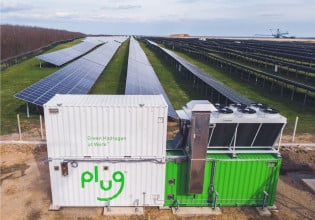Zenobe Delivers Battery Storage Services to Secure European Transmission Grid
Zenobē recently reached a battery storage milestone making its 100-megawatt transmission-connected battery operational in England.
With many areas of the world experiencing severe weather events, people are becoming more interested in options like battery-backup services. Battery storage specialist Zenobē has made its 100-megawatt (MW) transmission-connected battery operational–the largest of its kind in Europe and the first to connect to the United Kingdom.
Here’s a look at what this means for electricity reliability, sustainability, and more.

Battery energy storage. Image used courtesy of Adobe Stock
A Step Toward Sustainability
Located in Capenhurst, Chester, a village in England within the Mersey region, this battery storage project represents a major step toward clean energy targets and net-zero emission goals. A 15-year forecast suggests this initiative will prevent 1,004,040 tonnes of CO2 from entering the atmosphere.
Moreover, because this transmission-connected battery is in an area that benefits significantly from Scottish wind flows, it offers reactive power with less dependence on local gas plants. Residents will enjoy fewer power outages, lower energy bills, and more reliance on renewable energy.
This battery will provide service previously only handled by gas plants. Additionally, it equips the area’s grid to use more renewable energy, reducing its fossil fuel uptake. The resulting grid efficiency will make blackouts less likely. This battery can also import electricity during periods of heightened renewables production.
World’s First Reactive Power Contract
National Grid has paid millions of pounds per month to wind operators in exchange for those parties turning off their turbines. The organization had to do so when the grid became overwhelmed. However, the Capenhurst battery will save approximately £58 million in curtailment costs during its first 15 years of operation.
According to the company, its battery—connecting directly to Europe’s transmission network at 275,000 volts—helped Zenobē secure the world’s first reactive power contract. The battery came about through a National Grid Electricity System Operator Pathfinder initiative, which seeks alternative ways to provide inertia, resulting in a more stable, greener grid.
The goal was to address Mersey’s history of high-voltage issues with a cost-effective solution to absorb or inject reactive power, thereby keeping the transmission network’s voltage levels safe. Until now, fossil fuel plants were the sole provider of reactive power, but people associated with this battery project recognized the need to be future-oriented. After all, the Fiddler’s Ferry Power Station stopped operating in 2020 and used to serve the Mersey region.
The Capenhurst battery will play a major role in grid stability without relying on fossil fuels. With more consumers and companies thinking carefully about what they can do to preserve the planet, such sustainable projects are increasingly necessary and relevant.
Controlling Renewable Energy Generation
As great as it is to get energy from the sun or wind, there’s a well-known problem. Since the sun doesn’t shine and the wind doesn’t blow at a constant intensity 24 hours a day, renewable energy generation can’t be controlled. But there are ways to even out the influence of renewables on the grid. Battery storage solutions like the Mersey project are one example of the possibilities.

Renewable energy options. Image used courtesy of Pixabay
The Zenobē battery stores as much energy as 1,500 electric cars, smoothing out the grid’s power from renewable sources and preventing complications like lights dimming or wires becoming so hot they could melt due to the variability. Before battery options, gas peakers—which served as mini generators—were typically used to address the variability problem. However, battery energy storage is a major improvement in carbon emissions output.
Energy Storage Progress
The idea is that energy storage solutions like batteries allow for keeping the power and using it later rather than letting it go to waste. Energy storage has not historically been prioritized, but now that renewables are becoming more abundant and resource conservation is a greater concern, it’s a topic of increasing interest.
Zenobē is one of many focusing on energy storage options. Research shows grid-scale batteries will comprise most of the storage-related growth worldwide, with pumped-storage hydropower currently leading the way.






